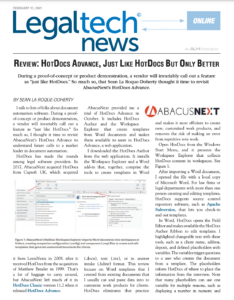Beyond Paperless: Make the Move to Effective Document Management

The law increasingly moves in digital flows: scanned engagement letters and contracts, legal briefs, pleadings, estate documents and wills, spreadsheets, images. Federal courts have embraced document management best practices and been paperless for years, and state courts are converting to electronic filing and paperless case files.
So your firm is now paperless, too – great! In the pandemic era, many firms can make that claim; some went paperless before 2020, and some transitioned rapidly in response to the lockdown. Even without the pandemic, a paperless model has been inevitable for some time.
Have you embraced a paperless document management strategy?
Still, for most organizations, some documents continue to arrive in paper form by mail. Initially, going paperless means that team members gather incoming paper documents and scan them into digital formats. So, yes, the content is digital, but is your information created, organized and shared in a way that supports efficient firm operations?
Document management processes that are rapidly becoming outdated
Many firms simply create a folder structure on a network drive or in Office 365 and save documents there. Some employees store documents on local drives or laptops, cloud storage apps like Box or Dropbox or even in email inboxes. Though the files are in digital form, organization and search issues persist.
Documents stored in a mailbox or on a local drive are not available to the team. When the need to share arises, they email documents to colleagues as attachments. This creates the problem of multiple versions of a document in multiple storage areas. (And that’s not even addressing the risks of sending confidential information in an email!)
As a next step, everyone in the firm agrees to share on the firm network. Some individuals may adopt their own file naming conventions or sort files into folders where colleagues would not think to look for them. With the shared-drive approach, training and policing employees on filing protocols is time-consuming and error-prone.
Optimal document management: create, organize and share
Going beyond paperless means optimizing technology to make documents and information easy to create, use, store, retrieve and share throughout the life of each document and matter.
An effective document management system that is integrated with a legal practice management environment offers an all-in-one solution for managing cases from initial client engagement through case closure. Legal document management software provides a built-in, matter-centric organizational system for all documents. Documents are not lost or misfiled. Details about each document are known and stored and provide valuable information for firm management and compliance.
 See why lawyers love HotDocs: Check out this Legaltech product review of HotDocs Advance to discover just how easy it is for your firm to get started.
See why lawyers love HotDocs: Check out this Legaltech product review of HotDocs Advance to discover just how easy it is for your firm to get started.
5 document management best practices
To go truly beyond paperless, consider these five steps on the journey. The optimal solution rests on document workflow automation, practice management and document management software that work together. The goal is to create, organize and share documents and information across the life of a case or document, while protecting clients’ sensitive information and complying with information retention standards.
1. Consistently create high-quality documents
From collaboration to storage and security, document management plays an important role in running a productive firm. And of course, streamlining document creation is step one for effective document management. For firms in document-heavy practices such as business contracts, real estate, employment or trademark law, there are tools that can help with digital document creation and assembly.
Documents created manually require hours of sometimes tedious effort and can be error-prone. Going beyond paperless ideally begins with automated creation of documents in a digital format for a faster and more efficient document control process. Document automation takes a static, business-critical document and turns it into a dynamic template that is easy to update, review and process.
For example, HotDocs document automation enables AbacusLaw users to create a new document template, edit an existing template, populate or “fill” an existing template for an existing client, access document properties and engage matters. When you run fill, HotDocs can pull in client and matter data for inclusion in the newly created document. Results are consistent, on-brand, of a high quality and take far less time than manual document creation.
2. Collaborate and share while working remotely
With more firms working remotely, everyone on the team needs access to work projects, case and client documents and information. Cloud-based practice management software solves that challenge: employees can access practice management tools, calendars, tasks and files from any internet-enabled device. Documents are also stored in a secure cloud, greatly reducing the maintenance effort and risk of hosting applications on-premises.
A document management system with collaboration tools helps firms work more effectively with clients, too. Initial engagement forms can be completed by the client in an online intake form. Clients are also increasingly accustomed to 24/7 access to information, and a law firm portal site allows them to share or receive documents whenever they want. E-signature integration allows convenient remote e-signing of agreements, contracts and forms with annotation features.
The best document management systems for law firms are also mobile-friendly. Attorneys are on the road, visiting clients and spending time in court. A mobile app that connects them to their case files, communications and documents keeps them productive around the clock.
3. Store documents for quick access and retrieval
The benefit of a true document management system is that it encourages and enables consistency in the naming, filing and organization of documents in the system. A new document can be saved in relation to the client name and matter and tagged by document type, author or other elements. Access can be limited to authorized firm users via role definition.
Once in the document management system, the content of a document will be organized and indexed, enabling users to rapidly search and filter by key words or names to view all documents related to a matter. The system tracks version control, so you know you are looking at the most current version. Quick access to documents and related comments by colleagues allows staff to have answers for the client in a phone call, with all the needed facts at hand. This transparent information management means that new attorneys and staff joining the firm or team members joining a case team have a seamless transition.
4. Protect sensitive client data
Law firms have been victims of hackers and ransomware threats, in part because firms create, manage and store sensitive legal, financial and strategic information about their clients. Firms can reduce the risk of data compromise or breach by electing to run firm operations and document management in a secure cloud environment. When enhanced document management is enabled, documents are encrypted and stored in a secure location. Users can safely check out documents, change them and then check them back in.
5. Meet archiving and compliance regulations
As a case comes to a close or a client leaves the firm, there are decisions to be made regarding the records and documents related to that client. The bar association in your state will have established guidelines on the requirements for retaining records. Some specifically address trust accounts and property records. There may be other guidance regarding retention requirements and destruction recommendations.
Bar associations may recommend that the document retention timeline you choose should take into account (1) responsibilities you have under the law (including court orders) and (2) preservation for a defense of claims against you. AbacusNext has considered the parameters of law firm archiving and compliance requirements and built support into our legal practice management and document management systems. Document metadata on each document – including dates, client, subject, case information, activity dates, etc. – helps identify older records for safe deletion under your retention policies.
Automated document management can easily become a reality for your firm
If going beyond paperless seems like a huge endeavor, remember:
- You may already be using a practice management system like AbacusLaw that offers document automation and document management as integrated features. It may simply be a case of making greater use of what you already have.
- If you are not on AbacusLaw with the HotDocs integration, talk to us. Our full-service team helps firms move data from existing sources right into an all-in-one practice management system. We can help you define the path forward.
Your firm can build growth and offer a great experience to clients when you’re able to create, organize and share documents and information and collaborate in a portal, while protecting clients’ sensitive information and complying with information retention standards.